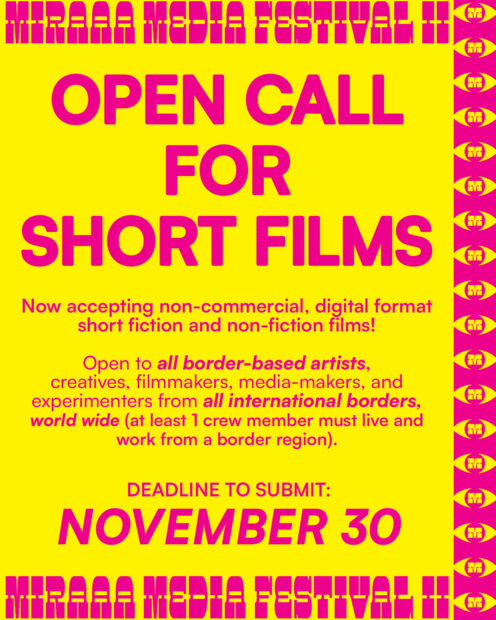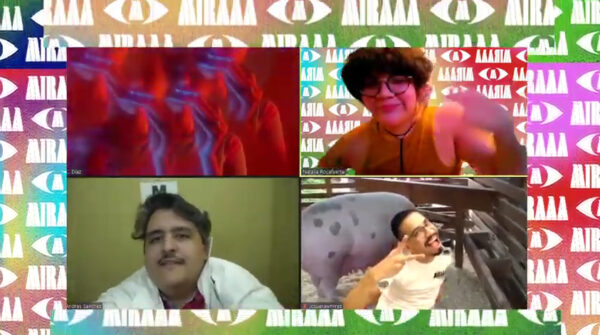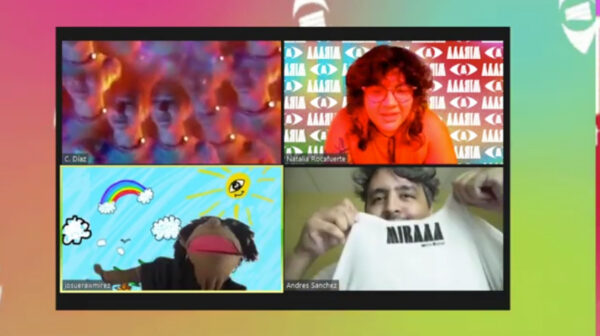Dedicated to speaking to the Valley and supporting border narratives told by local and international artists, MIRAAA Media Fest is a collaborative film and video art festival in the Rio Grande Valley (RGV). This is the second iteration of MIRAAA, which has an emphasis on collaboration, in particular between artist Natalia Rocafuerte, the ENTRE film center in Harlingen, the Laredo Film Society (LFS), Trucha in McAllen, and the Laredo-based Daphne Art Foundation through the NALAC Border Narratives Grant it received in 2021 to sponsor the first iteration of the festival.
MIRAAA was inspired by the 2020 Future Traditions Festival virtual stream, curated by Natalia Rocafuerte, one of MIRAAA’s original co-producers and collaborators. Josué Ramirez, Director of Trucha, was inspired to reach out to Rocafuerte after watching the festival’s film stream during the pandemic. At the time, Rocafuerte was based outside of Detroit, so she extended the project to include Andres Sanchez, a friend, artist, and talent booker based in the RGV, with the goal of focusing the experimental live stream on RGV artists. Sanchez makes it a point to “uplift artists that don’t have eyes on them. To merge the gap and familiarize artists with the community.” Through his connections with filmmakers, Sanchez, who is now a Co-Founder of MIRAAA Media, curated a screening that led him to meet C Diaz, Co-Founder of ENTRE and MIRAAA Media, who secured the McAllen Incubator as a venue for the screening and helped with production, awards, prizes, and PR work. The two of them teamed up with Lizett Montiel, Board Member of the LFS, and LFS to screen a block of programming at the festival. Montiel, also known as Rizu X, DJed the virtual after-party. Thus, MIRAAA Media Fest was born.
For this second iteration of the festival, with the help of Maritza Bautista, Executive Director of the Daphne Art Foundation, the collective decided to merge the artists of the RGV and Laredo to make it “a 956 festival,” referring to the area code representing the region. Together, they are shaping the festival as a collective; they combined their efforts to create the current open call and also an open call for collaborations between artists, filmmakers, and visual artists to produce a film. The latter is meant to create works that “may not have existed if the individuals never met,” Ramirez explained.
Ultimately, 12 collaborators were chosen from the open call, with six hailing from Laredo and the other six from the wider RGV. The selected artists will be paired with another local artist in order to collaborate on a commission to be featured at MIRAAA Media Fest. The curation process took the following into account for the selected artists: experiences in film/video production, artistic background, and creative interests, with the intent of pairing individuals who complement each other in skill and vision. The collaboration is meant to lean into experimentation, but there are no creative limitations besides a run time of 5-10 minutes. The selected collaborative duos will each be paid $600 on the completion of work.
The festival is open to all border-based artists, filmmakers, creatives, media-makers, and experimenters from all international borders, worldwide. On the decision to open submissions to international border artists, Diaz noted, “we know that living in borderlands is not a monolithic experience; there is much nuance throughout communities.” Díaz, Sanchez, and Ramirez illustrated that they want to give a “dose of the Valley, but [open] up the opportunity for those to submit across the world.” This openness allows people of the region to see what wider border communities look like. The collective aims to make these projects — experimental videos, films, and video art — viewable in both the RGV and Laredo. Sanchez added that the festival and collaboration are ways to “[push] new and up-and-coming creators to take a risk and get paid. [And to give] these types of work a space.”
When asked about why specifically the festival is focused on video art, Díaz, an experimental filmmaker themself, said, “The availability of tools such as smartphones has democratized media creation. And more access equals more voices sharing their unique stories and perspectives. Video art creates space for artists to experiment with image and sound, and audiences are often surprised by how the abstraction and manipulation can elicit an emotional response.” Ramirez followed, “Something as simple as a texture on experimental film can cause certain emotions.” Díaz continued bringing to light the benefits of exploring video art and film as a means of “getting out of your comfort zone as a creator.” Their vision is to showcase border narratives “away from stereotypes and sensationalism” through contemporary media and art.
When asked about the guidelines for the festival and collaborations, Ramirez, Díaz, and Sanchez spoke interchangeably. They are allowing any film, old or new, that specifically focuses on border life, with international borders in mind. “All of us are trying to shift what it means to be a border community, allowing these stories to be shared and told here and internationally,” Sanchez stated. At least one crew member for the film must live and work in a border region in order to submit to the MIRAAA Media Fest; submissions are free. They are accepting original work only, with up to three submissions per crew. Any submissions with music must have original or royalty-free music only. A maximum of two channels of audio and nothing higher than 4K in resolution will be accepted. Captioning is required. English subtitles are required.
The deadline to submit a non-commercial, digital-format short film, fiction or nonfiction, experimental video, or video art piece is November 30 via FilmFreeway. Upon acceptance to the festival, films will be eligible for the Best of Fest Award, the People’s Choice Award in RGV, and the People’s Choice Award in Laredo. Accepted artists will be notified January 6, 2024, and the festival will take place on Saturday, February 17, 2024, in Harlingen and Saturday, February 24, 2024, in Laredo.





